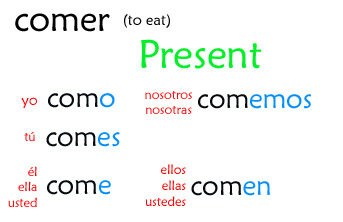Hola. This video lesson covers regular -ER verbs in the present tense. We also learn a couple of new verbs along the way and get to practice some miscellaneous vocabulary. If you haven’tThis video does reference the videos on regular -AR verbs, which you might watch before watching this video if you haven’t yet. Enjoy!
Feel free to leave any questions, comments or suggestions below!
ER verb endings (endings in blue):

Vocabulario:
hablar (to talk, speak)
beber – to drink
comer – to eat
creer – to think, believe
creer en – to believe in
creer que – to think that
deber – should, ought
leer – to read
mucho – much, a lot
el arroz – rice
no – no
las verduras – vegetables
los estudiantes – students
el libro de inglés – English book
la novela – novel
el libro – book
la hamburguesa – hamburger
los niños – children
creer que – to think that
el español – Spanish
es – he/she/it is
importante – important
el agua – water
hacer la tarea – to do homework
mi – my
los extraterrestres – aliens
Related video(s):
No, he won’t go out with you. Ja, Ja, Ja!
Will you go out with me?
luv u bro
Hola Señor Jordan!
My students love you so much and they absolutely love your videos. This truly is a special class because their eyes are like hawks. So, in this video (ER/IR verbs) they noticed in the yellow banner (when explaining about verbs in Spain) that it says, “ithe.” They were so excited to let you know because they pride themselves on being my best class! We really are thankful for all of your hard work and videos. They told me to put this: #fav#students#señorjordanrocks
what up dog thnxs a lot sr.j
i am waiting my answer Mr Jordan and if you’ll answer it,i will be happy.Thanks for yuor interest.
i dont understand exactly that you have given us “creer” is means think and also “creer” is means believe,too. Think and believe words are not exactly same word(the means are different each other)As I learned “think is pensar”, “believe is creer”…….Is there any wrong thing please let us know Sr. J….
dude!!!!!! my video isnt working out it wont load!!!!!!!!
my video didnt load :p
Me ha encantado la idea, me pareces un tÃo genial. Fijate que yo soy profe de inglés en España y estoy bajándome tus videos para intentar enseñarles inglés a mis alumnos. Me harÃa mucha ilusión que me respondieras. Un cordial saludo y sigue asà eres “mu salao”.
Ana
Sometime it would be nice if you could show the difference between “pensar” and “creer”. Many times people use “pensar” (“to think” in English) when they should be using “creer” (“to believe” in English) when speaking Spanish as in the common phrase “Cómo crees?” meaning “What are you thinking?” or in essence “What’s the matter with your thinking?” (How silly of you!). “Creer” is also used to say “I think so” as in “Creo que sÔ or “I don’t think so” as in “Creo que no”.
Gracias Bob.
That will have to be one of those more ‘advanced’ videos for really fine-tuning your Spanish. 🙂
Creo que (I believe) the difference in meaning is much more nuanced.
From what I’ve read, ‘creo que’ is more of an opinion that you’re not as sure about while ‘pienso que’ is something your more sure about.
Spanish speakers do also say: ‘Pienso que sÃ’ or ‘Pienso que no’ for ‘I think so’ & ‘I don’t think so’.
-Sr. J